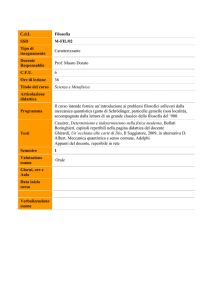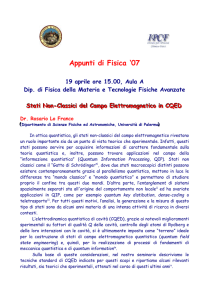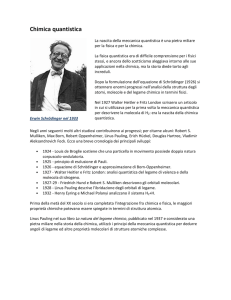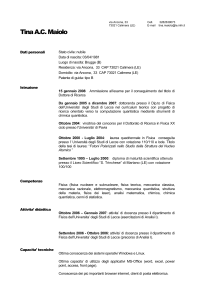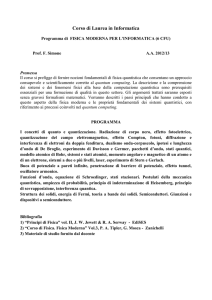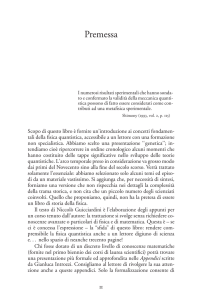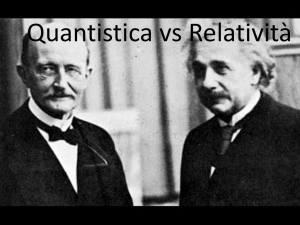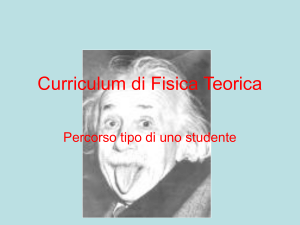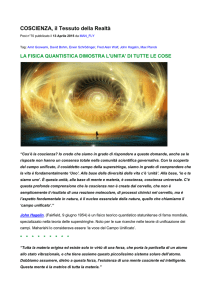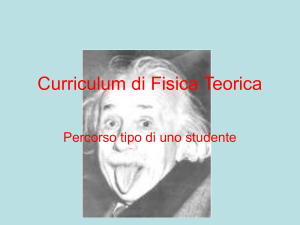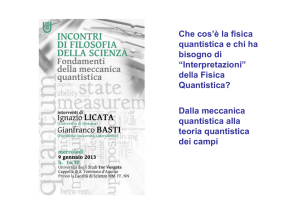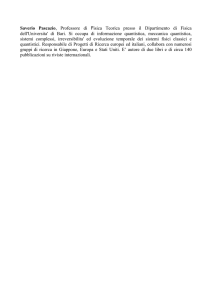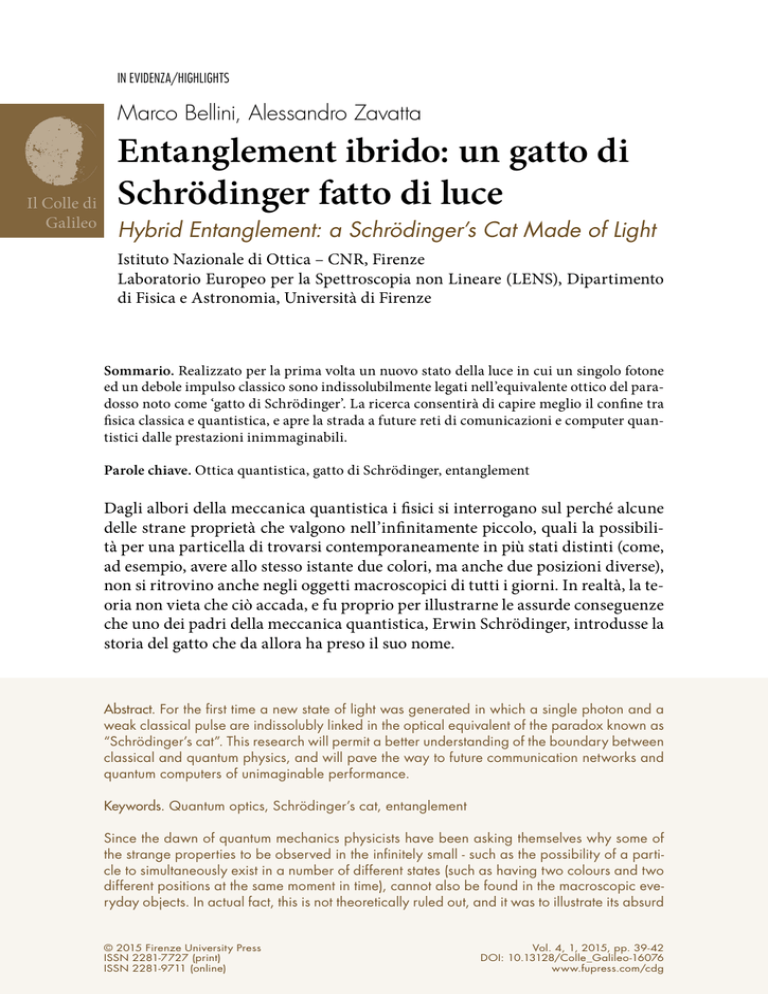
IN EVIDENZA/HIGHLIGHTS
Marco Bellini, Alessandro Zavatta
Il Colle di
Galileo
Entanglement ibrido: un gatto di
Schrödinger fatto di luce
Hybrid Entanglement: a Schrödinger’s Cat Made of Light
Istituto Nazionale di Ottica – CNR, Firenze
Laboratorio Europeo per la Spettroscopia non Lineare (LENS), Dipartimento
di Fisica e Astronomia, Università di Firenze
Sommario. Realizzato per la prima volta un nuovo stato della luce in cui un singolo fotone
ed un debole impulso classico sono indissolubilmente legati nell’equivalente ottico del paradosso noto come ‘gatto di Schrödinger’. La ricerca consentirà di capire meglio il confine tra
fisica classica e quantistica, e apre la strada a future reti di comunicazioni e computer quantistici dalle prestazioni inimmaginabili.
Parole chiave. Ottica quantistica, gatto di Schrödinger, entanglement
Dagli albori della meccanica quantistica i fisici si interrogano sul perché alcune
delle strane proprietà che valgono nell’infinitamente piccolo, quali la possibilità per una particella di trovarsi contemporaneamente in più stati distinti (come,
ad esempio, avere allo stesso istante due colori, ma anche due posizioni diverse),
non si ritrovino anche negli oggetti macroscopici di tutti i giorni. In realtà, la teoria non vieta che ciò accada, e fu proprio per illustrarne le assurde conseguenze
che uno dei padri della meccanica quantistica, Erwin Schrödinger, introdusse la
storia del gatto che da allora ha preso il suo nome.
Abstract. For the first time a new state of light was generated in which a single photon and a
weak classical pulse are indissolubly linked in the optical equivalent of the paradox known as
“Schrödinger’s cat”. This research will permit a better understanding of the boundary between
classical and quantum physics, and will pave the way to future communication networks and
quantum computers of unimaginable performance.
Keywords. Quantum optics, Schrödinger’s cat, entanglement
Since the dawn of quantum mechanics physicists have been asking themselves why some of
the strange properties to be observed in the infinitely small - such as the possibility of a particle to simultaneously exist in a number of different states (such as having two colours and two
different positions at the same moment in time), cannot also be found in the macroscopic everyday objects. In actual fact, this is not theoretically ruled out, and it was to illustrate its absurd
© 2015 Firenze University Press
ISSN 2281-7727 (print)
ISSN 2281-9711 (online)
Vol. 4, 1, 2015, pp. 39-42
DOI: 10.13128/Colle_Galileo-16076
www.fupress.com/cdg
40
Marco Bellini, Alessandro Zavatta
Schrödinger descrisse il caso di un gatto chiuso all’interno di un contenitore
ermetico insieme ad un atomo radioattivo e ad una fialetta di veleno. Con una
probabilità del 50%, l’atomo avrebbe potuto decadere, emettendo una particella
radioattiva che avrebbe rotto la fiala ed ucciso il gatto. Secondo le regole della fisica quantistica, ad un certo istante l’atomo avrebbe però potuto trovarsi anche in
una situazione intermedia, in cui è contemporaneamente decaduto e no. La fiala
di veleno sarebbe stata quindi allo stesso tempo sia rotta che intera, ed il povero
Visione artistica della condizione di entanglement ibrido tra lo stato di una particella quantistica di luce (un
fotone, a sinistra) e quello di un impulso ondulatorio classico (uno stato coerente, a destra).
Artistic vision of the condition of hybrid entanglement between the state of a quantum particle of light (a photon, on the
left) and that of a classical wave pulse (a coherent state, on the right).
consequences that one of the founding fathers of quantum mechanics, Erwin Schrödinger, introduced the story of the cat that has since taken his name.
Schrödinger described the case of a cat closed in a sealed box together with a radioactive
atom and a small flask of poison. With a 50% probability the atom could decay, emitting a radioactive particle that would break the flask and kill the cat. According to the rules of quantum
physics, at a given moment the atom could however have also found itself in an intermediate
situation, in which it was simultaneously decayed and not. The flask of poison would therefore
be both broken and intact at the same time, and the poor cat in a strange state in which it is
simultaneously both alive and dead.
Marco Bellini, Alessandro Zavatta
Entanglement ibrido: un gatto di Schrödinger fatto di luce
gatto in uno strano stato sospeso in cui è contemporaneamente sia vivo che morto.
Quello che, per la prima volta, hanno dimostrato sperimentalmente ricercatori dell’Istituto Nazionale di Ottica (INO) del Cnr e del Laboratorio Europeo
per la Spettroscopia non Lineare (LENS) dell’Università di Firenze, col supporto
di colleghi teorici coreani ed australiani, è stata la produzione di un cosiddetto
stato di luce “entangled” ibrido microscopico-macroscopico, cioè di un analogo
ottico della condizione “intrecciata” in cui si trovano l’atomo (microscopico) ed
il gatto (macroscopico) all’interno della scatola.
In questo caso, il ruolo dell’atomo è sostenuto da un singolo fotone, la particella fondamentale della luce, mentre quello del gatto da un debolissimo impulso di
luce classico. Se nella scatola è presente il fotone, allora l’impulso ha una ben determinata fase. Viceversa, se il fotone è assente, l’impulso di luce ha la fase opposta. Finché la scatola non viene aperta, cioè finché non viene effettuata una misura
che costringa il sistema a decidere tra le due alternative, le due situazioni sono vere allo stesso tempo. Il fotone è sia presente che assente e, corrispondentemente, il
debole impulso luminoso ha due fasi esattamente opposte, in uno stato intrecciato (“entangled”) ibrido che è l’esatto analogo di quello in cui si trovano il gatto di
Schrödinger (sia vivo che morto) ed il suo atomo radioattivo (sia decaduto che no).
Questo esperimento, che per la sua originalità ha meritato la copertina del numero di Luglio di Nature Photonics1, permetterà di capire meglio perché gli og‘Generation of hybrid entanglement of light’, H. Jeong, A. Zavatta, M. Kang, S. Lee, L.S.
Costanzo, S. Grandi, T.C. Ralph, M. Bellini, Nature Photonics 8, 564-569 (2014).
1 What was experimentally demonstrated, for the first time, by researchers from the National
Institute of Optics (INO) of the CNR and the European Laboratory for Non-Linear Spectroscopy (LENS) of the University of Florence, with the support of Korean and Australian colleagues,
was the production of a so-called state of hybrid “entangled” microscopic-macroscopic light,
that is of an optical version of the “entangled” condition of the (microscopic) atom and the
(macroscopic) cat inside the box.
In this case the role of the atom is played by a single photon, the elementary particle of
light, and that of the cat by a very weak pulse of classical light. If the photon is present in the
box, then the pulse has a well defined phase. On the contrary, if the photon is absent, the light
pulse has the opposite phase. Until the box is opened, that is until a measurement is made that
forces the system to decide between the two alternatives, both situations are true at the same
time. The photon is both present and absent, and – correspondingly – the weak light pulse has
two precisely opposite phases, in a hybrid entangled state which is an exact analogous to that
of Schrödinger’s cat (both alive and dead) and his radioactive atom (both decayed and not).
This experiment, the originality of which earned it the cover of the July issue of Nature
Photonics,1 will enable a better understanding of why macroscopic objects are never to be
‘Generation of hybrid entanglement of light’, H. Jeong, A. Zavatta, M. Kang, S. Lee, L.S. Costanzo,
S. Grandi, T.C. Ralph, M. Bellini, Nature Photonics 8, 564-569 (2014).
1 Hybrid Entanglement: a Schrödinger’s Cat Made of Light
41
42
Marco Bellini, Alessandro Zavatta
getti macroscopici non si trovino mai in questi strani stati sovrapposti, ed a che
livello le previsioni della Meccanica Quantistica smettano quindi di essere osservabili. Oltre a rispondere a domande di tipo quasi filosofico sul funzionamento
della Natura, la prima realizzazione di uno stato di luce dalle caratteristiche così
particolari consentirà di mettere a punto gli strumenti fondamentali (quali ripetitori, memorie e interfacce) per una futura rete di comunicazioni e computer
quantistici basati su singoli fotoni e su fasci di luce laser.
Marco Bellini. Primo ricercatore presso l’istituto Nazionale di Ottica del CNR di
Firenze. Si occupa di ottica quantistica e di interazioni radiazione-materia ad altissime intensità. Ha inoltre collaborato con Theodor W. Hänsch a ricerche fondamentali per lo sviluppo dei “pettini di frequenza” che sono valse a quest’ultimo
il premio Nobel per la Fisica 2005. E-mail: [email protected]
Alessandro Zavatta. Ricercatore presso l’istituto Nazionale di Ottica del CNR
di Firenze. Si occupa di ottica quantistica e, in special modo, della generazione,
manipolazione e rivelazione della luce al livello dei singoli fotoni. Le sue ricerche hanno consentito di verificare sperimentalmente leggi fondamentali di fisica
quantistica. E-mail: [email protected]
Web page: http://www.ino.it/home/QOG/
found in these strange superposed states, and hence at what level the predictions of Quantum
Mechanics cease to be observable. In addition to responding to questions of an almost philosophical flavour regarding how Nature works, the very first generation of a state of light with
such particular characteristics will make it possible to refine the basic tools (such as repeaters,
memories and interfaces) for future communication networks and quantum computers based
on individual photons and beams of laser light.
Marco Bellini. Senior researcher at the National Institute of Optics of the CNR in Florence. His
main areas of research are quantum optics and laser-matter interactions at very high intensities. He has also collaborated with Theodor W. Hänsch on research fundamental to the development of the “frequency combs” that earned Hänsch the Nobel Prize in Physics in 2005.
E-mail: [email protected]
Alessandro Zavatta. Researcher at the National Institute of Optics of the CNR in Florence. His
research is engaged with quantum optics, and in particular the generation, manipulation and
detection of light at the level of individual photons. His work has enabled him to experimentally verify fundamental laws of quantum physics.
E-mail: [email protected]
Web page: http://www.ino.it/home/QOG/
Marco Bellini, Alessandro Zavatta

